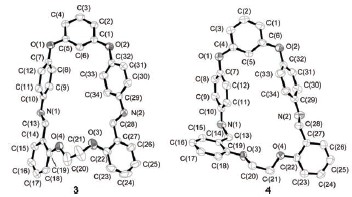| [1] Srimurugan, S.; Viswanathan, B.; Varadarajan, T. K.; Varghese, B. Org. Biomol. Chem. 2006, 4, 3044.[2] Daniel, G. R.; Ludger, A. W. J. Am. Chem. Soc. 2009, 131, 3721.[3] Wang, M.-X. Chem. Commun. 2008, 4541.[4] Wang, Z.; Reibenspies, J.; Martell, A. E. Inorg. Chem. 1997, 36, 629.[5] Ding, C.-X.; Ni, J.; Yang, Y.-H.; Ng, S.-W.; Wang, B.-W.; Xie, Y.-S. CrystEngComm 2012, 14, 7312.[6] Matthews, R. W.; Mary, M.; Scowen, I. J. J. Chem. Soc, Dalton Trans. 1997, 2861.[7] Zhang, J.-Q.; Jia, C.-Y. Chin. J. Org. Chem. 2010, 30, 1142 (in Chinese).(张家强, 贾春阳, 有机化学, 2010, 30, 1142.)[8] Hu, P.; G, S-Y.; Zhang, Q.-L.; Zhang, Y.-Q.; Zhu, B.-X. Chin. J. Org. Chem. 2013, 33, 325 (in Chinese).(胡鹏, 郭思颖, 张奇龙, 张云黔, 朱必学, 有机化学, 2013, 33, 325.)[9] Vigato, P. A.; Tamburini, S.; Bertolo, L. Coord. Chem. Rev. 2007 251, 1311.[10] Hou, K.-N.; Yan, H.-L.; Dai, L.; Yuan, H.-H.; Li, X.-X.; Zhao, B. Chin. Chem. Bioeng. 2009, 10, 39 (in Chinese).(侯可宁, 颜海龙, 代丽, 袁慧慧, 李信信, 赵斌, 化学与生物工程, 2009, 10, 39.)[11] Liu, D.-M. M.S. Thesis, Jilin University, Changchun, 2009 (in Chinese).(刘冬美, 硕士论文, 吉林大学, 长春, 2009.)[12] Sheldrick, G. M. SHELX-97, University of Göttingen, Germany, 1997.[13] Özkar, S.; Üíkü, D.; Yíldírím, L. T.; Biricik, N.; Gümgüm, B. J. Mol. Struct. 2004, 688, 207.[14] Sessler, J. L.; Katayev, E.; Pantos, G. D.; Scherbakov, P.; Reshetova, M. D.; Khrustalev, V. N.; Lynch, V. M.; Ustynyuk, Y. A. J. Am. Chem. Soc. 2005, 127, 11442.[15] Sellamuthu, A.; Kamalraj, S.; Varghese, B.; Johnpaul, M.; Muthusamy, K. Inorg. Chem. 2012, 51, 5580.[16] Andrew, L. V.; Nathaniel, W. A.; Daryle, H. B.; Joseph, A. H. Inorg. Chem. 1997, 36, 5132.[17] Yuan, Z.-L.; Zhang, Q.-L.; Zhu, B.-X. Chin. J. Org. Chem. 2006, 26, 1590 (in Chinese).(袁泽利, 张奇龙, 朱必学, 有机化学, 2006, 26, 1590.)[18] Ravikumar, I.; Pradyut, G. Chem. Soc. Rev. 2012, 41, 3077.[19] Evgeny, A. K.; Nikolay, V. B.; Victor, N. K.; Yuri, A. U.; Tananaev, I. G. Jonathan, L. S. J. Org. Chem. 2007, 72, 2886. |
